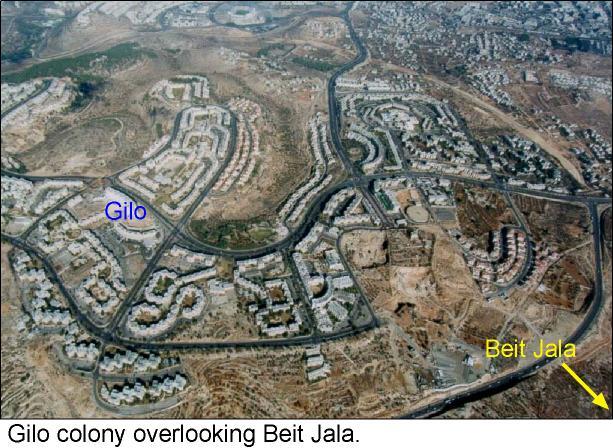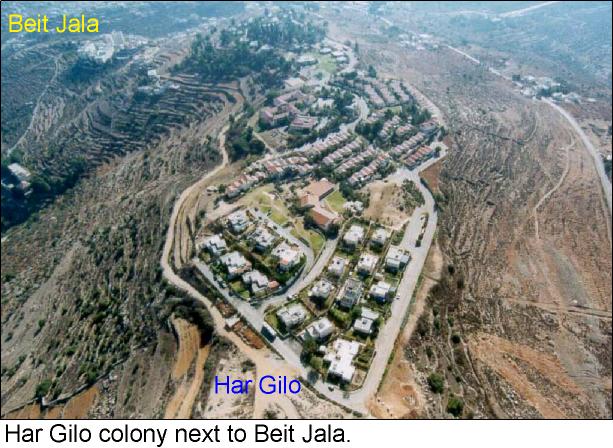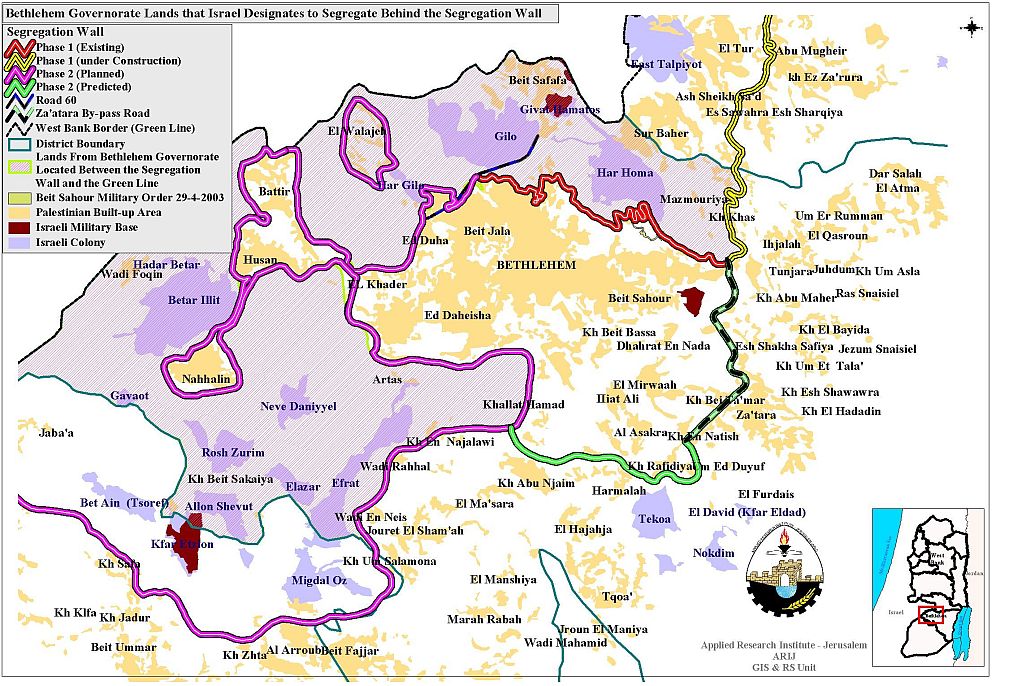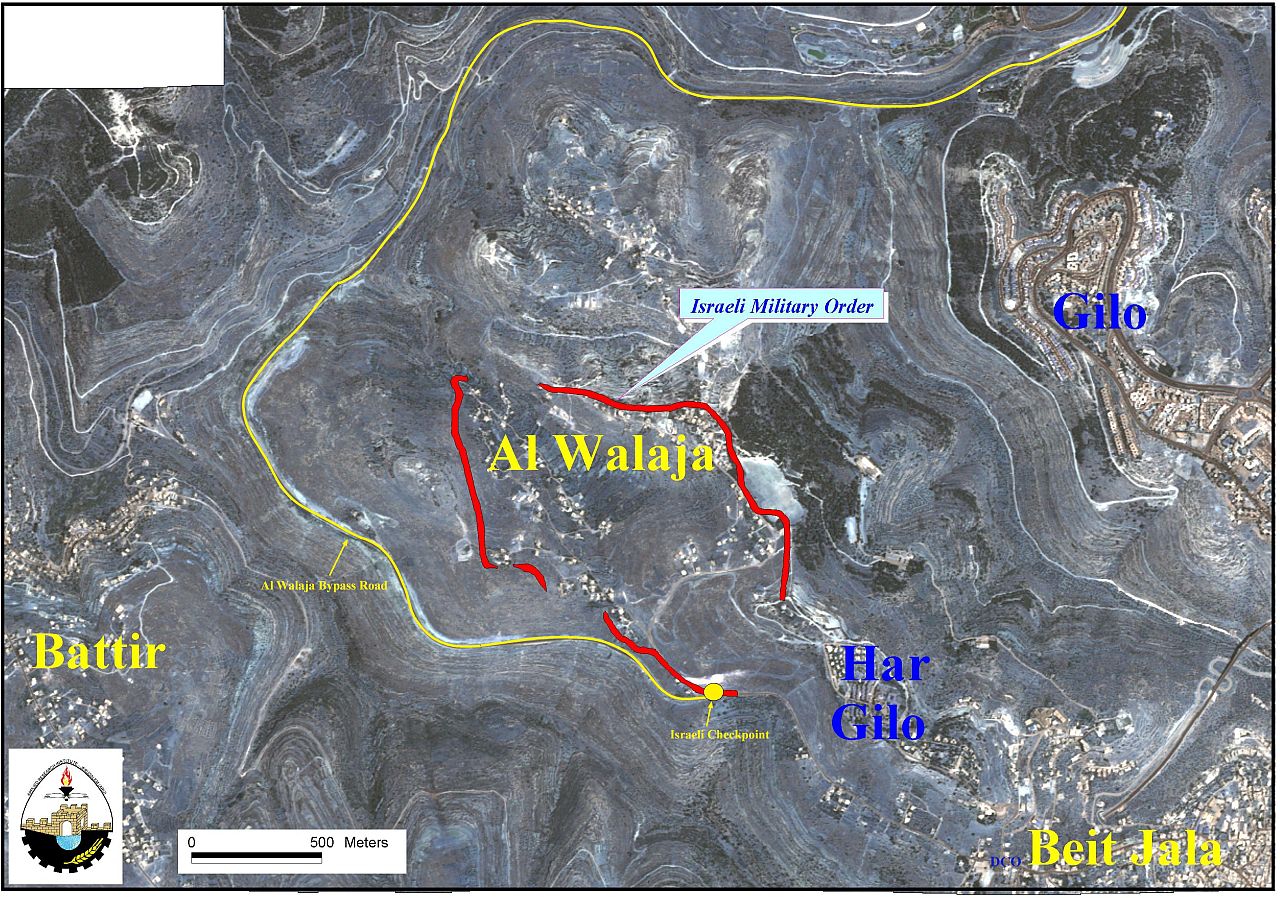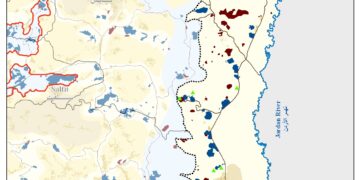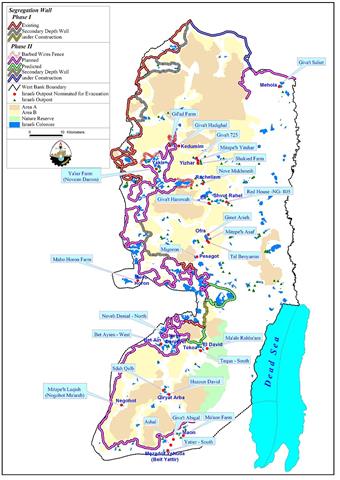Besides being victims of the Israeli occupation, Palestinians are daily facing the Israeli threat of confiscating their land especially after Israel started implementing its Segregation plan in June 2002. The Israeli military have stepped up actions of confiscation anddestroyed Palestinian lands and properties besides enforcing security control over the roads they use and preventing them from reaching their lands. The implementation of the Segregation Wall besides tightening the internal and external closures in the West Bank through checkpoints, roadblocks and the course of daily humiliation people face, and the long delays caused by the Israeli soldiers are preventing most Palestinians from reaching their work places, schools or universities, trade markets and other social services.
Al Walaja, a Palestinian village located to the northwest of Bethlehem district is a typical example of the Israeli practices. The village was completely destroyed during the 1948 war and the villagers rebuilt it again east of the 1949 Armistice Line inside the West Bank territories. Following the 1967 war, Israel declared vast areas of the West Bank as State Lands designated for settlements, natural reserves and closed military areas and started to change and expand Jerusalem's boundaries by annexing more lands from Bethlehem district. Israel occupied the new Walaja village 6 km far from Bethlehem city and included its north western part to the illegally expanded Jerusalem borders.
Today Al Walaja is threatened by the expansions of Har Gilo Israeli settlement, which was built on Palestinian lands confiscated from the Palestinian residents living at the neighboring town of Beit Jala. Har Gilo settlement has an area of 360 Dunums and over 400 settlers. Recently, new expansions in the area surrounding the settlement and to the east of Al-Walaja are taking place. In the early nineties an Israeli bypass road connecting Har Gilo settlement with Jerusalem was constructed through Al-Walaja lands to facilitate the settlers' movement to reach Jerusalem . See satellite image of Gilo and Har Gilo
During the second Intifada that took place in September 2000, the Israeli military forces closed the only main road leading to Bethlehem by 2 checkpoints, the first located near Al-Walaja village main entrance, and the second is the DCO checkpoint located west of the neighboring Beit Jala town, which obstructed the free movement of Al-Walaja residents to reach the urban center of Bethlehem where all services, social infrastructure facilities and markets are located. Those checkpoints are most of the time closed, sometimes the Israeli military forces open the DCO checkpoint from 7 am to 7 pm, but usually there are delays and traffic jams encountered at this checkpoint. It is worth to mention here that 3 abortion cases were recorded at this checkpoints resulting from preventing the citizens to reach the hospitals in Bethlehem. This situation forced Al-Walaja residents to use the only alternative narrow road (Cremisan road) in longer way to reach Bethlehem.
On August 12, 2003, a military order no.03/44/T was issued by Gadi Ezinkot, the Israeli Commander of Yehuda and Samaria region, ordering the annexation of 23.8 dunums of lands belonging to Palestinians from AL-Walaja and Beit Jala residents. The usual Israeli claim behind this seizure was for ''security needs'', see the military order
The route of the land being seized is clearly showing the intention behind such a violation; to circulate Al Walaja village as a part of the so called 'Jerusalem envelope'. A military fenced road started to circulate the village from its four sides and limits the possibility for any natural expansion besides imprisoning the inhabitants of the village in a ghetto, while cutting off its northwestern part which lies within the Israeli illegal boundary of Jerusalem.
In addition, the construction of the Segregation Wall inside the Palestinian Territories and the razing of Palestinian land for its construction clear the way for further expansion of the Israeli settlements that are planned to be annexed to Israel. Particularly in Bethlehem Governorate, the Segregation Wall is planned to have a length of 50 kilometers and will segregate more than 70 thousand dunums from Bethlehem lands that belong to Palestinians, most of those lands are located in the governorates' Western periphery where Al-Walaja is located. See Map of Bethlehem
According to the latest Israeli plan, which was published on the Internet at the Israeli Ministry of Defense Website; the village of Al-Walaja, will be totally isolated in a completely disconnected canton. See Map of Al Walaja and the Segregation wall.
Cremisan road mentioned earlier is an alternative road which goes through the Cremisan convent (Salesian Seminary) private property was always used by Al-Walaja inhabitants as an alternative road to go to Bethlehem. The road was refurbished and asphalted recently through the help of the United States government to the Palestinian People and the project was funded by the USAID in order to provide access to the village and facilitate the movement for the villagers to reach Bethlehem.
On January 11, 2004, theIsraeli bulldozers closed Cremisan 'road leading to Al Walaja village at the site of ''Ein Jwayza'', dug a trench in the new refurbished road and closed it with earthed mounds restricting the movement of Al-Walaja inhabitants and hence cutting off the village from any surrounding Palestinian community, which left the village as a big cage. It is winter time and villagers are now facing tremendous difficulties while trying to get out of the village. They are forced to walk on foot on dirt and mud trying to reach their destination.
Ghettos seem to be an Israeli fashion imposed on the Palestinian villages. The Israeli Land grabs policy, the daily harassment, and violations of the simplest human rights and UN Resolutions are continuous in the Palestinian Territories without real interference from the International community to stop Israel. How can Security and Peace be reached and prevail while the lives, the lands and natural resources, the sources of income and freedom of movement of the Palestinian people are mislaid.
Related Topics
Prepared by:
The Applied Research Institute – Jerusalem


